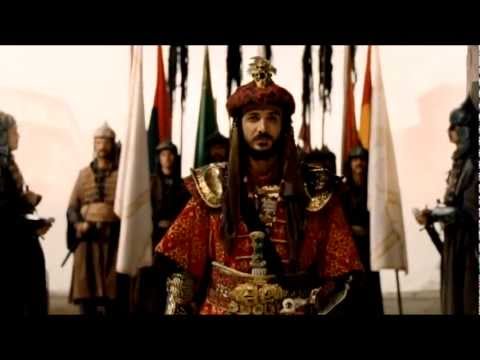

Roumeli Hissar Castle, built by Sultan Mehmed II between 14, before the Fall of Constantinople Mehmed II conducted first campaign against İbrahim of Karaman Byzantines threatened to release Ottoman claimant Orhan. İbrahim Bey of Karaman invaded disputed area and instigated various revolts against Ottoman rule. Following death of Murad II in 1451, Mehmed II became sultan for second time. In 1446 Murad II returned to throne, Mehmed II retained the title of sultan but only acted as a governor of Manisa. Instead, it was Çandarlı Halil Pasha's effort to bring Murad II back to the throne. Halil Inalcik states that Mehmed II did not ask for his father. If I am the sultan I hereby order you to come and lead my armies." Then, Murad II led the Ottoman army and won the Battle of Varna on 10 November 1444. According to the 17th-century chronicles, Mehmed II wrote, "If you are the sultan, come and lead your armies. At this time Mehmed II asked his father Murad II to reclaim the throne, but Murad II refused. Cardinal Julian Cesarini, the representative of the Pope, had convinced the king of Hungary that breaking the truce with Muslims was not a betrayal. In Mehmed II's first reign, he defeated the crusade led by John Hunyadi after the Hungarian incursions into his country broke the conditions of the truce Peace of Szeged in September 1444. Īfter Murad II made peace with Hungary on June 12, 1444, he abdicated the throne to his 12-year-old son Mehmed II in July /August 1444. The influence of Akshamsaddin in Mehmed's life became predominant from a young age, especially in the imperative of fulfilling his Islamic duty to overthrow the Byzantine empire by conquering Constantinople. He was influenced in his practice of Islamic epistemology by practitioners of science, particularly by his mentor, Molla Gürani, and he followed their approach. This Islamic education had a great impact in molding Mehmed's mindset and reinforcing his Muslim beliefs. Sultan Murad II also sent a number of teachers for him to study under. When Mehmed II was eleven years old he was sent to Amasya with his two lalas (advisors) to govern and thus gain experience, per the custom of Ottoman rulers before his time. His father was Sultan Murad II (1404–1451) and his mother Hüma Hatun, a slave of uncertain origin. Mehmed II was born on 30 March 1432, in Edirne, then the capital city of the Ottoman state. Among other things, Istanbul's Fatih district, Fatih Sultan Mehmet Bridge and Fatih Mosque are named after him. He is considered a hero in modern-day Turkey and parts of the wider Muslim world. At home he made many political and social reforms, encouraged the arts and sciences, and by the end of his reign, his rebuilding program had changed Constantinople into a thriving imperial capital.

Mehmed continued his conquests in Anatolia with its reunification and in Southeast Europe as far west as Bosnia. Nonetheless, Mehmed II viewed the Ottoman state as a continuation of the Roman Empire for the remainder of his life, seeing himself as "continuing" the Empire rather than "replacing" it. The claim was only recognized by the Patriarchate of Constantinople.

At the age of 21, he conquered Constantinople (modern-day Istanbul) and brought an end to the Byzantine Empire.Īfter the conquest Mehmed claimed the title Caesar of the Roman Empire (Ottoman Turkish: قیصر روم, romanized: Qayser-i Rûm), based on the fact that Constantinople had been the seat and capital of the surviving Eastern Roman Empire since its consecration in 330 AD by Emperor Constantine I. When Mehmed II ascended the throne again in 1451 he strengthened the Ottoman navy and made preparations to attack Constantinople. In Mehmed II's first reign, he defeated the crusade led by John Hunyadi after the Hungarian incursions into his country broke the conditions of the truce Peace of Szeged. Mehmed, pronounced 30 March 1432 – ), commonly known as Mehmed the Conqueror (Ottoman Turkish: ابو الفتح, romanized: Ebū'l-fetḥ, lit.'the Father of Conquest' Turkish: Fatih Sultan Mehmed), was an Ottoman sultan who ruled from August 1444 to September 1446, and then later from February 1451 to May 1481. Mehmed II ( Ottoman Turkish: محمد ثانى, romanized: Meḥmed-i s̱ānī Turkish: II.


 0 kommentar(er)
0 kommentar(er)
